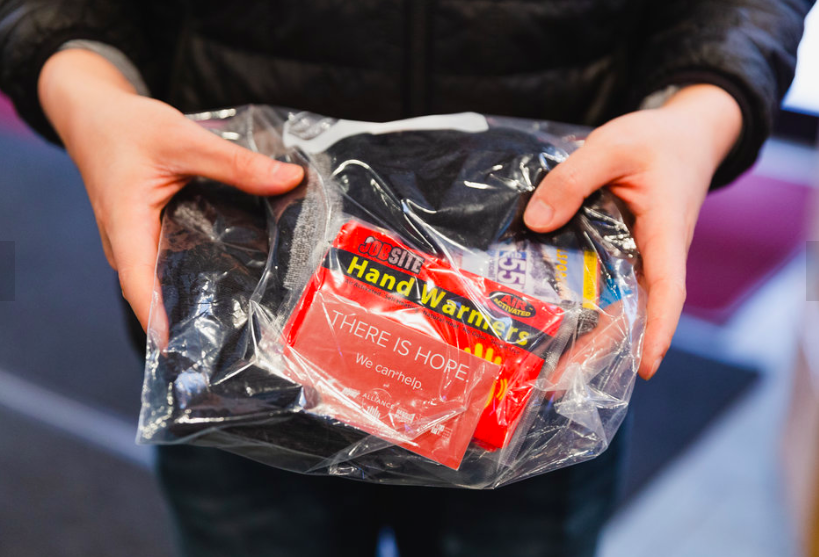W83 Newsletter Feature January 2020
"There Is Hope" | New York Rescue Alliance
Interview with Richard Vernon of New York Rescue Alliance's Don't Walk By
Don't Walk By is an annual winter outreach to our neighbors surviving on the street, a partnership between over half a dozen New York City-based organizations. Over the past decade, Don’t Walk By volunteers have canvassed the streets of Manhattan, met over 10,000 individuals and invited them back to a host site where guests are offered a hot meal, clothing, basic medical care, and connection to ongoing support.
When did you get involved with Don’t Walk By?
My background is in long-term recovery, and I’m normally doing community preparedness and hurricane response, as Deputy Director of Partnership for Emergency Services at Salvation Army. But our department has vans, so we were asked to lend some vans for the 2017 Don’t Walk By outreach. So we wound up agreeing to drive on the last week.
What was your first experience with Don’t Walk By like?
At some point, each of us walked through the site where we were welcoming guests. Because of the configuration of the space, the podiatry team was in the same room as the meal, and as I watched, I saw several pairs of people at the podiatry station. Usually one was a guy who looked like he was living on the street, with his socks and shoes off, and his fairly gnarly foot in the lap of a person in scrubs who was tenderly treating his feet, tending his wounds, putting on his socks and finding the right pair of donated shoes. It gave me this whole emotional punch: “this is what foot-washing really is.” At the end of the night we said, “we have to keep doing this.”
How did you wind up running an outreach to homeless people, with a background in disaster relief?
When I went to my first Don’t Walk By planning meeting, I realized, “Oh, this is a tiny long-term recovery group. I know this world.” The expertise in the room about homelessness, and what life is like on the street, and what it’s like to navigate the shelter system, was knowledge I didn’t have. They were the experts. But when I heard all the things that were tripping them up, that they weren’t sure about, I thought, “There’s a disaster answer to that.”In the long-term recovery model, you get all the organizations that have any piece of the puzzle talking, and planning to fill the gaps, so that you have a holistic approach. Nobody has to stop being who they are. But we’re talking so that we can get things done together. As I was doing recovery work with Hurricane Sandy, I had thought, this model would work for systemic poverty, institutional racism, homelessness and housing vulnerability.
So I talked to my boss about these organizations that were working together to address homelessness, and said, “Between us, they know all the things we don’t know, and we know at least some of the things they don’t.” So we started to talk to our Rescue Alliance partners, and then we were asked if we would be in charge of running the outreach.
How is homelessness like a disaster?
We treat homelessness like a disaster because homelessness is a slow-moving disaster.People who are homeless, and people who have just been through natural disasters or acts of terrorism, are completely at the mercy of the whims of government programs and the kindness of strangers. It is very much the same sort of trauma and social vulnerability.
And if you look at the Red Cross shelter numbers in the US, in 2017, they sheltered north of 40,000 people. But that is just two-thirds of the number of our neighbors sheltered nightly in New York City’s shelter system. The numbers are disaster numbers. The needs are disaster needs.
How does disaster response work in meeting the needs of homeless people?
The response that works with homelessness is what works in disaster. We need all the phases simultaneously, including community preparedness. And having somebody housed is disaster mitigation in a lot of ways.
Disaster case management involves much more hand-holding than regular social work, because people going through disasters don’t operate as well as they normally do. It’s harder to make good decisions, stay on a calendar, keep the acronyms sorted, all that sort of stuff. A Disaster Case Manager’s job is to help people navigate the programs, when this form has to be filled and submitted, stay on top of things for the person they’re working with, basically.
As we were listening to our friends at New York City Relief describe their day to day job doing street outreach, we thought, “That’s disaster case management for homelessness.” This level of case management, the intensity of which would normally feel far too invasive, is what works for people in deep crisis.
How has Don’t Walk By grown, and how do you hope it will grow?
It's great to be able to flex and improvise in the moment, but as we get good at doing a thing, we can begin to make plans based on our lessons learned. This year, we’ll be providing a vegan option, because we’ve found we have guests who need that option in past years. We will still be called to be flexible and improvise, but it will be with bigger things. Instead of improvising to see if we can get people a meal that won’t upset their stomachs because of dietary restrictions, we’re improvising to get them into permanent housing.

